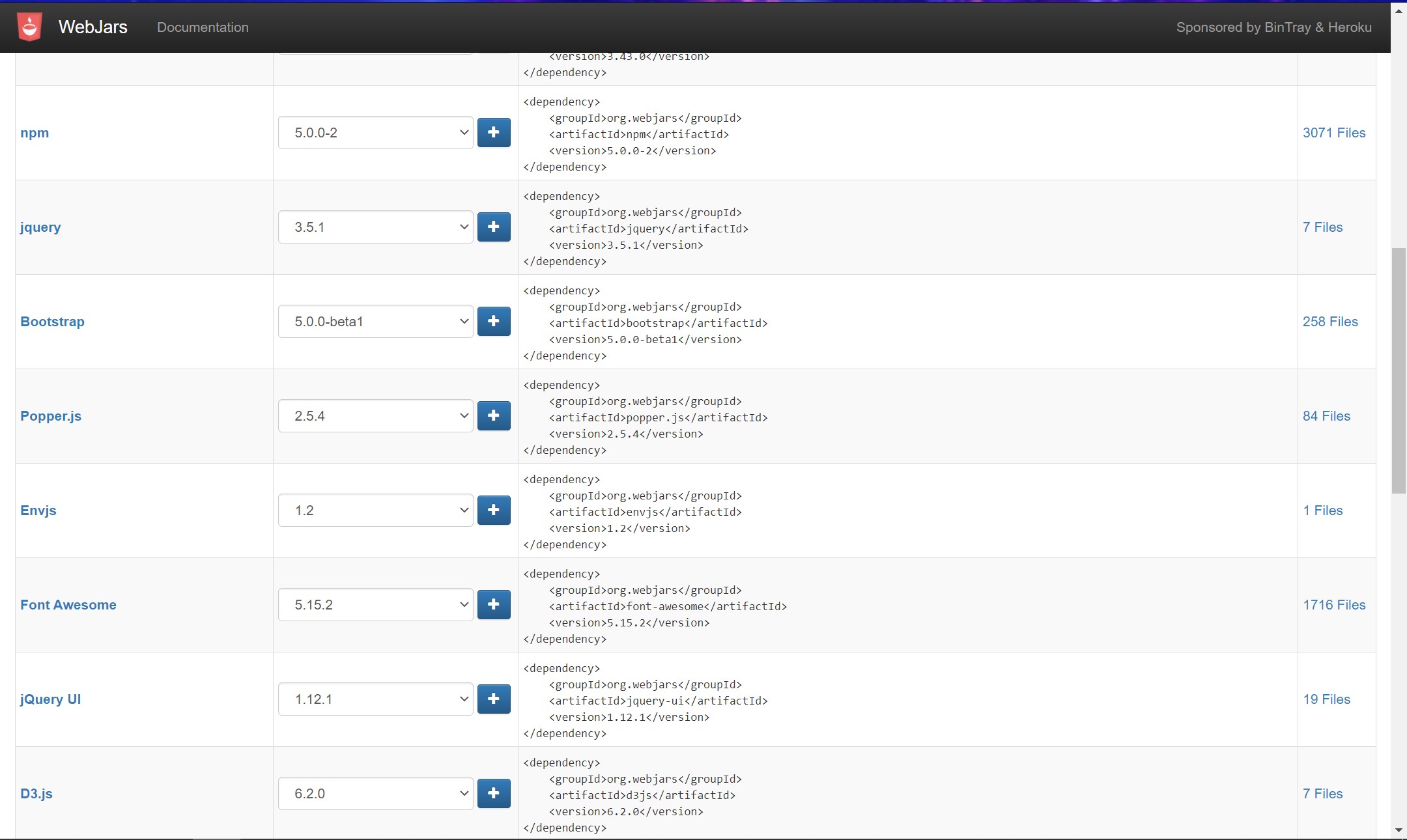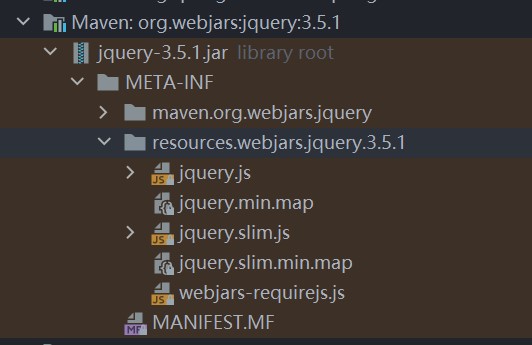SpringBoot Web 开发
# SpringBoot Web 开发
# 静态资源可用位置
在 WebMvcAutoConfiguration 类中存在 addResourceHandlers 方法:
@Override
public void addResourceHandlers(ResourceHandlerRegistry registry) {
// 根据if中的条件可知,若自定义了静态资源的路径,默认静态资源配置将会失效,方法将会直接返回,
if (!this.resourceProperties.isAddMappings()) {
logger.debug("Default resource handling disabled");
return;
}
Duration cachePeriod = this.resourceProperties.getCache().getPeriod();
CacheControl cacheControl = this.resourceProperties.getCache().getCachecontrol().toHttpCacheControl();
// 由第二个if及其中的代码可知,存在这样一个访问静态资源路径即webjars中的所有资源,例如localhost:8080/wabjars/jquery.js,
// 且这个访问路径会被映射到classpath:/META-INF/resources/webjars/
// 也就是说在浏览器输入的webjars等价于实际结构中的classpath:/META-INF/resources/webjars/
if (!registry.hasMappingForPattern("/webjars/**")) {
customizeResourceHandlerRegistration(registry.addResourceHandler("/webjars/**")
.addResourceLocations("classpath:/META-INF/resources/webjars/")
.setCachePeriod(getSeconds(cachePeriod)).setCacheControl(cacheControl)
.setUseLastModified(this.resourceProperties.getCache().isUseLastModified()));
}
// 以下代码通过读取默认的路径设置获取静态资源路径,这个配置存在于WebMvcProperties中
String staticPathPattern = this.mvcProperties.getStaticPathPattern();
if (!registry.hasMappingForPattern(staticPathPattern)) {
customizeResourceHandlerRegistration(registry.addResourceHandler(staticPathPattern)
.addResourceLocations(getResourceLocations(this.resourceProperties.getStaticLocations()))
.setCachePeriod(getSeconds(cachePeriod)).setCacheControl(cacheControl)
.setUseLastModified(this.resourceProperties.getCache().isUseLastModified()));
}
}
2
3
4
5
6
7
8
9
10
11
12
13
14
15
16
17
18
19
20
21
22
23
24
25
26
27
isAddMappings() 方法定义在 WebProperties 类中,这个类上有一个 @ConfigurationProperties("spring.web") 注解,说明这个类可以通过 spring.web 前缀的配置进行设置,在 application.yml 中输入如下内容,所有默认静态资源路径都会失效:
spring:
web:
resources:
add-mappings: false
2
3
4
关于 webjars:
进入 webjars 官网即可获取对应的依赖。

webjars 实现了使用 jar 包依赖引入 web 资源。
以 jQuery 为例,首先在 Maven 中添加依赖:
<dependency>
<groupId>org.webjars</groupId>
<artifactId>jquery</artifactId>
<version>3.5.1</version>
</dependency>
2
3
4
5

根据对源代码的分析,要想访问 jQuery,只需要在浏览器输入 localhost:8080/webjars/jquery/3.5.1/jquery.js。
默认静态资源路径:
WebMvcProperties 的 getStaticPathPattern() 方法返回一个 String 字符串。
private String staticPathPattern = "/**";
if 中的代码中有:
this.resourceProperties.getStaticLocations()
此方法在 WebProperties 中的内部静态类 Resources 中定义,返回一个 String 数组:
private static final String[] CLASSPATH_RESOURCE_LOCATIONS = { "classpath:/META-INF/resources/",
"classpath:/resources/", "classpath:/static/", "classpath:/public/" };
2
说明访问 /** 的资源会被转换为项目中的四个 CLASSPATH_RESOURCE_LOCATION,且优先级为 resources > static > public,例如访问 localhost:8080/test.js 会根据优先级访问 resources、static、public 中的 test.js。
可以通过配置文件的方式改变映射路径 /** 为其他路径,例如:
spring:
mvc:
static-path-pattern: /hello/**
2
3
配置后,访问 /hello 下的资源才会被映射,例如原先访问 localhost:8080/test.js 要更改为 localhost:8080/hello/test.js。
# 首页和图标定制
# 首页
在 WebMvcAutoConfiguration 类中存在 welcomePageHandlerMapping 方法:
@Bean
public WelcomePageHandlerMapping welcomePageHandlerMapping(ApplicationContext applicationContext,
FormattingConversionService mvcConversionService, ResourceUrlProvider mvcResourceUrlProvider) {
WelcomePageHandlerMapping welcomePageHandlerMapping = new WelcomePageHandlerMapping(
new TemplateAvailabilityProviders(applicationContext), applicationContext, getWelcomePage(),
this.mvcProperties.getStaticPathPattern());
welcomePageHandlerMapping.setInterceptors(getInterceptors(mvcConversionService, mvcResourceUrlProvider));
welcomePageHandlerMapping.setCorsConfigurations(getCorsConfigurations());
return welcomePageHandlerMapping;
}
2
3
4
5
6
7
8
9
10
其中调用了 getWelcomePage:
private Optional<Resource> getWelcomePage() {
String[] locations = getResourceLocations(this.resourceProperties.getStaticLocations());
return Arrays.stream(locations).map(this::getIndexHtml).filter(this::isReadable).findFirst();
}
2
3
4
这个方法又调用了 getStaticLocations 方法,返回一个 location 字符串数组:
private static final String[] CLASSPATH_RESOURCE_LOCATIONS = { "classpath:/META-INF/resources/",
"classpath:/resources/", "classpath:/static/", "classpath:/public/" };
/**
* Locations of static resources. Defaults to classpath:[/META-INF/resources/,
* /resources/, /static/, /public/].
*/
private String[] staticLocations = CLASSPATH_RESOURCE_LOCATIONS;
2
3
4
5
6
7
8
可以看到,这个值就是上面提到的四个静态资源路径:
此外,welcomePageHandlerMapping 方法还调用了 WebMvcProperties 的 getStaticPathPattern() 方法,返回值默认就是上面提到的 /**。
getWelcomePage 还调用了 getIndexHtml 方法,并且传入的参数就是上面的四个 location:
private Resource getIndexHtml(String location) {
return this.resourceLoader.getResource(location + "index.html");
}
2
3
:: tip 首页名称必须是 index.html,且必须放在默认静态资源路径下,默认访问路径如:localhost:8080,若修改了 static-path-pattern 为其他路径,则无法访问 index。 :::
# 图标定制
最新版本 SpringBoot 中已经移除了图标的设置,若使用老版本,在静态资源文件夹中放置一个 favicon.ico 文件,并修改配置文件,关闭默认图标:
spring:
mvc:
favicon:
enabled: false
2
3
4